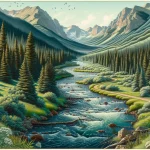This scenic byway transports travelers back in time along a historic narrow gauge railroad while providing access to breathtaking alpine scenery and year-round recreational activities.
In This Article
TL;DR
- Boreas Pass Road follows a historic railroad route over the Continental Divide, offering glimpses into Colorado's past.
- The area provides boundless outdoor recreation, from mountain biking and hiking to wildlife viewing and seasonal foliage tours.
- Historical attractions like abandoned mining towns and preserved railcars add to the mystique.
Overview of Boreas Pass Area
Winding through the heart of Summit County, Boreas Pass Road crosses the Continental Divide at an elevation of 11,481 feet. The rugged and beautiful terrain encompasses alpine tundra, sheer mountain peaks, and lush valleys dotted with wildflowers. The narrow dirt roadway rolls over the subalpine landscape, passing remnants of Colorado’s mining and railroad history.
The cool mountain air and high altitude create a stimulating backdrop for adventures. The Boreas Pass area offers boundless recreation, from mountain biking and hiking to off-roading and snowshoeing. The variety of trails caters to all ability levels, making this an ideal destination for families and hardcore thrill-seekers.
When the colors erupt in the fall, visitors flock to Boreas Pass Road to immerse themselves in the golden hues of fluttering aspens. The annual Tour Divide bike race also utilizes this route, drawing crowds of cheering fans. Yet despite these seasonal influxes, Boreas Pass retains an untouched wildness year-round.
Experiencing Local Culture
Boreas Pass Road provides a direct connection to Colorado’s frontier past. Following the old railroad grade transports visitors back to the state’s founding years. Interpretive signs detail the railroad’s construction and its role in opening up the Western Slope. Preserved railcars and remnants of snow sheds enhance the living history.
Nearby ghost towns also showcase Colorado’s mining heritage. Visitors can explore the abandoned buildings and machinery left behind when the mines dried up. These former boom towns offer a glimpse into the state’s rough-and-tumble early days.
Outdoor Adventures
The Boreas Pass area offers no shortage of heart-pumping thrills. During the summer, mountain bikers test their skills on the surrounding trails. Options range from family-friendly routes to advanced terrain along the popular Colorado Trail. Hikers also delight in the alpine scenery, with trails leading to secluded lakes and lofty summits, including Boreas Mountain. The popular Boreas Pass Trailhead is located close to Breckenridge and can be accessed from Boreas Pass Road.
In the winter, the road provides snowshoeing and backcountry skiing opportunities with stunning vistas. Cross-country ski trails wrap around frozen lakes, while steeper lines tempt the adventurous.
Families appreciate the variety of activities as well. Interpretive nature trails detail the local flora and fauna, with sightings of bighorn sheep, marmots, and moose possible. Youngsters also enjoy exploring the relics the narrow gauge railroad left behind, sparking the imagination of Colorado’s wild past.
Historical Significance
As an ambitious narrow gauge route constructed in the late 1800s, the railroad over Boreas Pass symbolized Colorado’s pioneering spirit. Built by the Colorado and Southern Railway, the line provided a vital transportation link across the Continental Divide for over 40 years. The railroad enabled commerce and development, connecting Denver to prosperous mining towns like Breckenridge.
The line required ingenious engineering to traverse the rugged alpine environment. Constructing snow sheds and cuts into the mountainsides provided avalanche protection in the harsh winters. Remnants of these features still stand, offering insight into the monumental undertaking.
The railroad was eventually dismantled in the 1930s after falling into decline. Yet the legacy lives on along Boreas Pass Road, where interpretive displays describe the corridor’s history. Visitors can walk along the former rail bed while envisioning the smoke-billowing locomotives that once chugged by. Preserved railcars in nearby towns also showcase this unique period in Colorado’s past.
Diverse Ecosystems
The Boreas Pass area provides opportunities to experience a variety of high-altitude ecosystems. The road traverses multiple climate zones. Visitors pass through subalpine forests dotted with quaking aspens in the lower valleys before emerging atop the tundra. This stark alpine environment features miniature wildflowers and grassy meadows populated by specialized animal species.
At these elevations, the bristlecone pine displays its resiliency. These gnarled patriarchs have survived over 1,500 years in harsh conditions, and their twisted forms paint a living portrait of the extreme climate. Other alpine species, like bighorn sheep and yellow-bellied marmots, have also adapted to the dramatic seasonal shifts.
This high-altitude biodiversity provides rewards for wildlife watchers and photographers. Patient observers may spot moose wading through wetland areas or Rocky Mountain goats blending into the craggy cliffs. Quiet hikers can glimpse cautious pikas gathering grasses among the talus slopes.
Seasonal Recreation
While summer offers boundless high-altitude adventures, Boreas Pass Road also shines during the fall and winter. Vibrant displays of golden aspens lining the roadway draw leaf peepers each September and October. The occasional dusting of snow on these peaks heightens the drama. Visitors revel in the blazing colors while photographing the majestic mountain backdrop.
As the snow deepens, the recreation shifts gears. Cross country skiers and snowshoers wander through a frosted winter wonderland. The white-blanketed railroad grade provides routes to quiet valleys and scenic vistas.
Yet Boreas Pass Road also entices auto travelers year-round. The scenic drive provides stunning vistas from the comfort of a heated car. Wildlife sightings are common even during colder months. Interpretive signs detailing the surrounding history and nature exist for perusal regardless of the season.
Tour Divide Race
Since its inception in 2005, the Tour Divide bikepacking race has traveled over 2,700 miles along the Continental Divide from Canada to Mexico. This grueling competition traverses Boreas Pass, making it a popular spot for spectators.
Racers endure the full gamut of terrain and weather along the route. Cyclists climb over high passes and navigate mud-caked trails while carrying their necessary camping gear. Cold temperatures, hail storms, and snow add to the suffering.
The Boreas Pass section provides a milestone for racers. Crowds congregate here to cheer on the athletes, offer supplies, and document the race’s progress. The festivities also showcase the passion this area inspires for outdoor adventure.
Conservation Efforts
A cooperative effort helps maintain the scenic beauty and biodiversity showcased along Boreas Pass Road. Sections of the byway pass through White River National Forest, where sustainable forestry practices safeguard ecosystems. Adjacent wilderness areas also limit development’s impact on natural habitats and wildlife corridors.
The nonprofit Summit Historical Society protects cultural heritage as well. Preserving historic railcars and buildings and designating interpretive signage keeps the area’s colorful history alive. Visitors gain a window into the past while treasuring these monuments for future generations.
Travelers also play a role through responsible tourism. Respecting trail etiquette, properly disposing of waste, and leaving no trace all help conserve Boreas Pass Road’s splendor. Conscient stewardship of the natural and cultural resources ensures the preservation of this Colorado gem.
FAQ
How long is Boreas Pass Road?
Spanning approximately 25 miles from end to end, Boreas Pass Road takes about an hour to drive without stopping for sightseeing. Plan for longer with stops to take in the views, explore historical attractions, hike trails, or photograph the fall colors.
Does Boreas Pass Road require 4WD?
No, the well-maintained dirt road is passable for 2WD passenger cars during snow-free months. But high clearance vehicles are recommended for comfort, and 4WD allows access to more adventurous offshoots.
What is there to do along Boreas Pass Road?
Outdoor recreation like hiking, mountain biking, and cross-country skiing draw most visitors. But the scenic drive itself offers great views of historical attractions and colorful fall vistas to captivate travelers. Interpretive signs also detail nature and heritage.
What wildlife might I see?
Herds of bighorn sheep frequently graze the high-altitude slopes. Lucky travelers could also spot moose, elk, marmots, pikas, mountain goats, or myriad bird species. Patient hikers may also glimpse a bobcat or black bear.
When do the aspens change color?
Fall colors crescendo through September and early October most years, with cooler nighttime temperatures ushering in the gold hues. However, the display varies annually depending on weather conditions. Locals suggest targeting late September for the most vibrant leaf-peeping.
So whether you are a history buff, thrill-seeking cyclist, or aspiring photographer, Boreas Pass Road offers something to enchant. The rich heritage, abundant recreation, and breathtaking scenery converge to provide the quintessential Colorado experience. One only needs an adventurous spirit to unlock Boreas Pass Road’s treasures.






